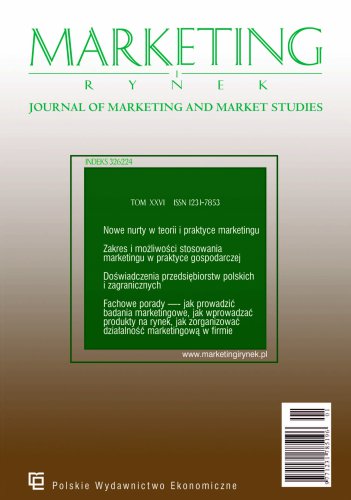Efektywność i jakość wybranych publicznych uczelni funkcjonujących w Polsce
Celem artykułu jest przedstawienie i wykorzystanie metodyki oceny funkcjonowania uczelni wyższych. W artykule zastosowano proponowaną przez autora metodykę do oceny efektywności oraz jakości czołowych publicznych uczelni funkcjonujących na terenie Polski. Podstawą proponowanej metodyki jest z jednej strony spostrzeżenie, że uczelnia realizuje dwa główne procesy różniące się istotnie charakterem nakładów oraz uzyskiwanych produktów i efektów — dydaktykę i badania. Z drugiej strony dla uzyskania kompleksowej oceny uczelni ważne jest zwrócenie uwagi na dwa obszary — efektywność funkcjonowania oraz generowaną jakość, rozumianą jako wpływ uczelni na otoczenie. Prezentowane w artykule wyniki oceny przeprowadzonej według metodyki zaproponowanej przez autora wskazują, że najwyższy poziom efektywności zarówno w przypadku realizacji procesu dydaktyki, jak i realizacji badań osiągnął Uniwersytet Warszawski. Wyniki te pokazały także możliwości, jakie daje proponowana metodyka, jednak zdaniem autora istotna jest również refleksja nad doborem i źródłami analizowanych danych.
Bibliografia
Bibliografia/References
Bradley, S., Johnes, J. i Little, A. (2006). The measurement and determinants of efficiency and productivity in the FE sector in England. Lancaster University Management School Working Paper, 62, 1282–1297.
Brint S. i Clotfelter, C. T. (2016). U.S. Higher Education Effectiveness. RSF: The Russell Sage Foundation Journal of the Social Sciences, 2(1). https://doi.org/10.7758/rsf.2016.2.1.01
Brzezicki, Ł. i Prędki, A. (2018). Pomiar efektywności publicznych szkół wyższych za pomocą metod DEA, SFA oraz StoNED. Wiadomości Statystyczne, 684(5), 5–24. https://doi.org/10.5604/01.3001.0014.0648
Camanho, A. S. i Dyson, R. G. (2005). Cost efficiency, production and value-added models in the analysis of bank branch performance. Journal of the Operational Research Society, 56(5), 483–494. https://doi.org/10.1057/palgrave.jors.2601839
Charnes, A., Cooper, W. W. i Rhodes, E. (19798). Measuring the Efficiency of Decision Making Units. European Journal of Operational Research, 2(6), 427–444. https://doi.org/10.1016/0377-2217(78)90138-8
Cunha Vera Rocha, M. (2012), On the Efficiency of Public Higher Education Institutions in Portugal: An Exploratory Study. CEF. UP, FEP-UP and CIPES.
Dwórznik, M. (2018). Efektywność i jakość w szkolnictwie wyższym. Niepublikowana praca doktorska. Warszawa: Uniwersytet Warszawski.
GUS (2016). Szkoły wyższe i ich finanse 2015. Warszawa: Główny Urząd Statystyczny.
Hayder Abbas Drebee i Nor Azam Abdul-Razak (2018). Measuring the Efficiency of Colleges at the University of Al-Qadisiyah-Iraq: A Data Envelopment Analysis Approach (Mengukur Kecekapan Kolej-Kolej di Universiti Al-Qadisiyah-Iraq: Satu Pendekatan Analisis Data Envelopment). Jurnal Ekonomi Malaysia, 52(3), 163–179. https://doi.org/10.17576/JEM-2018-5203-12
Johnes, J. (2006). Data envelopment analysis and its application to the measurement of efficiency in higher education. Economics of Education Review, 25(3), 273–288.
Kaneko, M. (1997). Efficiency and equity in Japanese higher education. Higher Education, 34(2). https://doi.org/10.1016/j.econedurev.2005.02.005
Kao, C. i Ya-Chi Lin. (1999). Libri, 49(3), 150–158. https://doi.org/10.1515/libr.1999.49.3.150
Kao, L-J, Lu, C-C i Chiu, C-C. (2011). The training institution efficiency of the semiconductor institute programme in Taiwan-application of spatiotemporal ICA with DEA approach. The Journal of the Operational Research Society, 62(12), s. 2162–2172. https://doi.org/10.1057/jors.2010.177
Leitner, K., Prikoszovits, J., Schaffhauser-Linzatti, M., Stowasser, R. i Wagner, K. (2007). The impact of size and specialisation on universities’ department performance: A DEA analysis applied to Austrian universities. Higher Education, Springer Netherlands, 53(4), 517–538. https//doi.org/10.1007/s10734-006-0002-9
Liga, P. (2014). Cause Analysis of Students' Dropout Rate in Higher Education Study Program Article in Procedia. Procedia — Social and Behavioral Sciences, 109(3), 1282–1286 Social and Behavioral Sciences Latvia University of Agriculture. https://doi.org/10.1016/j.sbspro.2013.12.625
Lita, I. (2018). Data Envelopment Analysis Techniques — DEA and Malmquist Indicators, in CRS Mode, for Measuring the Efficiency of Romanian Public Higher Education Institutions. Economic computation and economic cybernetics studies and research/Academy of Economic Studies, 52(3/2018), 249–264. https://doi.org/10.24818/18423264/52.3.18.17
Mcmillan, M. i Datta, D. (1998). The relative efficiencies of Canadian universities: a DEA perspective. Canadian Public Policy — Analyse de Politiques, 24(4), 485–511. https://doi.org/10.2307/3552021
Parasuraman, A., Zeithaml, A. V. i Berry, L. (1985). A Conceptual Model od Service Quality and Its Implications for Future Research. Journal of Marketing, 49, 41–50. https://doi.org/10.1177/002224298504900403
Pietrzak, P. i Gołaś, M. (2018). Zeszyty Naukowe SGGW — Ekonomika i Organizacja Gospodarki Żywnościowej, 122, 17–28. https://doi.org/10.22630/EIOGZ. 2018.122.11
Portela, M. C. S., Camanho, A. S. i Borges, D. (2012). Performance assessment of secondary schools: The snapshot of a country taken by DEA. Journal of the Operational Research Society, 63(8), 1–18. https://doi.org/10.1057/jors.2011.114
Ramírez-Correa, P., Pena-Vinces, J. C. i Alfaro-Pérez, J. (2012). Evaluating the efficiency of the higher education system in emerging economies: Empirical evidences from Chilean universities. African Journal of Business Management, 6(4), 1441–1448. https://doi.org/10.5897/AJBM11.1982
Reichmann, G. (2004). Measuring University Library Efficiency Using Data Envelopment Analysis. Libri, 54, 136–146. https://doi.org/10.1515/LIBR.2004.136
Song, X. (2018). Analysis for Capital Investment Efficiency in Higher Education of Northeast China Based on DEA Model. Educational Sciences: Theory and Practice, 18(6).
Taylor, B. i Harris, G. (2004), Relative efficiency among South African universities: a data envelopment analysis. Higher Education, 47(1), 73–89. https://doi.org/10.1023/B:HIGH.0000009805.98400.4d
Taylor, E. S. i Tyler, J. H. (2012). The Effect of Evaluation on Teacher Performance. The American Economic Review, 102(7). https://doi.org/10.1257/aer.102.7.3628
Taylor, J. (2011). Efficiency by performance indicators? Evidence from Australian higher education. Trietary Education and Management, (7). https://doi.org/10.1080/13583883.2001.9967038
Teichler, U. (2014). Opportunities and problems of comparative higher education research, the daily life of research. Higher Education, 67(4), 393–408. https://doi.org/10.1007/s10734-013-9682-0
Teichler, U. (2013). Universities Between the Expectations to Generate Professionally Competences and Academic Freedom Experiences from Europe. Elsevier Ltd. Procedia — Social and Behavioral Sciences, 77, 421–428. https://doi.org/10.1016/j.sbspro.2013.03.097
Thanassoulis, E., Kortelainen, J. G. i Johnes, J. (2011). Costs and efficiency of higher education institutions in England: a DEA analysis. Journal of the Operational Research Society, 62(7), 1282–1297. https://doi.org/10.1057/jors.2010.68
Velychko, O., Velychko, L. I Kharytonov, M. (2018). Managing Efficiency in Higher Education: A Case of Ukrainian Universities. Social Scienes, 7. https://doi.org/10.3390/socsci7080138
Wolszczak-Derlacz, J. (2016), Assessment of TFP in European and American higher education institutions — application of Malmquist indices. Technological and Economic Development of Economy, 24(3), 1–22. https://doi.org/10.3846/20294913.2016.1213197

